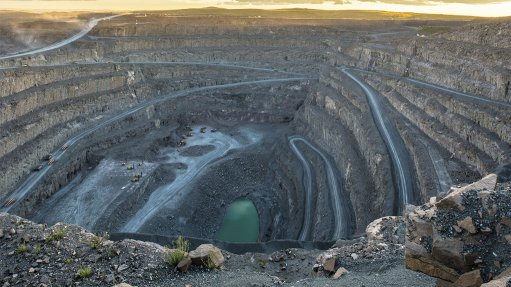Froneman calls for collective action towards zero harm in fatality-plagued mining business

Sibanye-Stillwater CEO Neal Froneman presenting half-year results covered by Mining Weekly Online’s Mining Weekly Online. Photographs: Duane Daws. Video and Video Editing: Darlene Creamer. Recorded 22.2.2018
A strong call to action was made last week by Sibanye-Stillwater CEO Neal Froneman for a common purpose to achieve zero harm in South Africa’s mining industry, where rising fatality numbers are causing great concern.
Froneman said a point had been reached where management on its own could not make the difference that was required.
“Unless all stakeholders step up to the plate, we’re not going to make a difference to our safety,” he said at the Johannesburg- and New York-listed company’s presentation of half-year operating and financial results, adding that safety had reached a plateau that needed to be broken through.
“If we are at a point where people’s attitudes are resulting in accidents and we can’t solve that, then I’m not sure we can mine in such an environment,” he said, warning that a halt to mining on the grounds of it being unsafe would have huge knock-on consequences.
“We need to get together and we need to talk about this – so [this is] a call to action for a common purpose towards zero harm,” he added, which coincided with a slide flashed up onto a large screen headlined: ‘Safety compact required’.
He drew attention to South Africa’s improved political environment and said he was encouraged by the extent of the informal interaction between government and business to foster understanding of what is needed to deal with problem-causing issues.
He pledged the full support of Sibanye-Stillwater for inclusive economic growth through mining, taking part in constructive engagement initiatives and creating positive momentum.
Half of the company’s earnings before interest, taxation, depreciation and amortisation (Ebitda) were now arising from platinum group metals (PGMs) and lossmaking gold operations had been closed, which was providing resilience to the current strong rand environment.
“If spot prices stay where they are, we’re not going to make a lot of money out of our gold business, but we’re also not going to go down the tubes,” Froneman said at the results conference, in which Creamer Media’s Mining Weekly participated.
Sibanye, he said, had realised more than R1-billion in yearly synergies since taking over Rustenburg Platinum Mines at low cost from Anglo American Platinum.
“Labour-intensive operations, if run correctly, can be highly productive and cost effective,” he said, while flashing a slide onto the screen showing the company’s mines positioned in the lower half of the cost curve.
The 282 631 oz of palladium and platinum produced in the US at an all-in sustaining cost (AISC) of $660/oz in the six months to December 31 sold at a basket price of just under $1 000/oz.
A record throughput of 517 000 recycled ounces contributed $15-million to Ebitda.
The 1 194 348 oz of PGMs produced by Sibanye’s South African platinum operations in the six months exceeded guidance and the 714 300 oz of gold produced by its South African mines was 4% higher than in the first six months of 2017, despite the closure of the Cooke operation, on the West Rand.
“What’s remarkable is that these assets not that long ago were generating significant losses at very similar spot prices,” Froneman told fund managers, analysts and journalists.
“We believe we’re resilient to the current strong rand environment without any financial instruments,” he added.
Sibanye calculates its AISC for its South Africa gold operations at $1 126/oz, the lowest of South African gold mining companies.
Owing to the new tax legislation in the US, the corporate income tax rate falls to 21% in 2018 from a previous 35%.
“This rate has the effect of bringing down our deferred tax liability by $205-million,” CFO Charl Keyter reported.
The company, he said, was still well within its debt covenants of 3.5 times net debt-to-Ebitda until the end of 2018 and two times thereafter.
“Where the strong rand is now, we need to make some plans, and the operations are already well advanced with that. If you look at the various scenarios . . . it will take us about four years to de-lever and we’re very comfortable with the scenarios that we’ve planned,” Keyter said.
“Primary focus is deleveraging the balance sheet. That is certainly an overhang in the market. We understand that and, under the strong rand environment, we need to demonstrate our ability to remain cash-flow positive under that, but, also, we need to highlight the large amount of cash that’s being generated by our operations in the US, and our Lonmin transaction has been done in a way that doesn’t consume cash. Producing cash to bring down our debt is important, and the political change . . . in South Africa is going to address our South African discount,” Froneman said.
“We’re not ex-growth. Pursuing value- accretive opportunities is still a focus, but it cannot be done using cash at this stage and, certainly until the value of our equity is something different, we can’t use our equity either; so, I suppose for the next while, we’ll really just hunker down and deleverage and consolidate our business,” he added.
Answers to analysts’ questions on the acquisition of Lonmin revealed that it is incumbent on Lonmin to reduce its employee complement, which will take place whether or not the transaction goes ahead.
Adjusted Ebitda for the South African gold operations for the year ended December 31 declined by 46% to R5.3-billion on a 7% decline in production to 1.4-million ounces and a 9% decline in the average gold price to $1 254/oz.
South African PGM operations contributed R1.6-billion, or 18%, to group adjusted Ebitda.
Primarily owing to the increase in borrowings arising from the acquisition of Stillwater, net finance expenses for the six months ended December 31 rose R963-million year-on-year to R1 312-million.
The group recorded a net profit for the six months of R370-million, compared with R2 955-million for the comparable period in 2016.
Comments
Press Office
Announcements
What's On
Subscribe to improve your user experience...
Option 1 (equivalent of R125 a month):
Receive a weekly copy of Creamer Media's Engineering News & Mining Weekly magazine
(print copy for those in South Africa and e-magazine for those outside of South Africa)
Receive daily email newsletters
Access to full search results
Access archive of magazine back copies
Access to Projects in Progress
Access to ONE Research Report of your choice in PDF format
Option 2 (equivalent of R375 a month):
All benefits from Option 1
PLUS
Access to Creamer Media's Research Channel Africa for ALL Research Reports, in PDF format, on various industrial and mining sectors
including Electricity; Water; Energy Transition; Hydrogen; Roads, Rail and Ports; Coal; Gold; Platinum; Battery Metals; etc.
Already a subscriber?
Forgotten your password?
Receive weekly copy of Creamer Media's Engineering News & Mining Weekly magazine (print copy for those in South Africa and e-magazine for those outside of South Africa)
➕
Recieve daily email newsletters
➕
Access to full search results
➕
Access archive of magazine back copies
➕
Access to Projects in Progress
➕
Access to ONE Research Report of your choice in PDF format
RESEARCH CHANNEL AFRICA
R4500 (equivalent of R375 a month)
SUBSCRIBEAll benefits from Option 1
➕
Access to Creamer Media's Research Channel Africa for ALL Research Reports on various industrial and mining sectors, in PDF format, including on:
Electricity
➕
Water
➕
Energy Transition
➕
Hydrogen
➕
Roads, Rail and Ports
➕
Coal
➕
Gold
➕
Platinum
➕
Battery Metals
➕
etc.
Receive all benefits from Option 1 or Option 2 delivered to numerous people at your company
➕
Multiple User names and Passwords for simultaneous log-ins
➕
Intranet integration access to all in your organisation

















